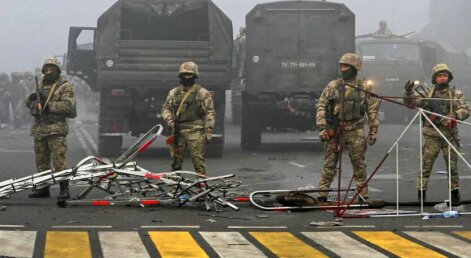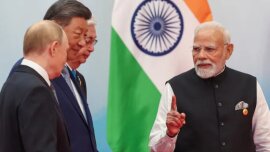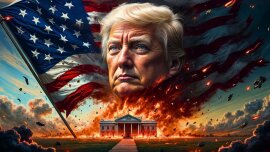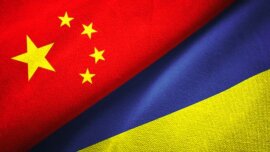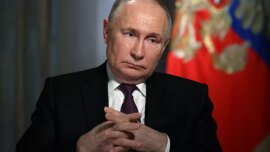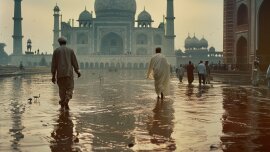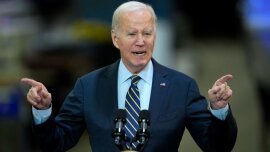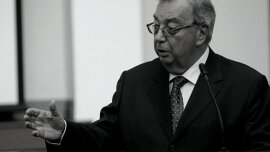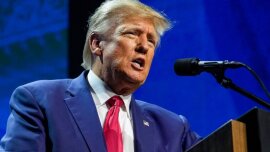Against the background of other Central Asian countries, Uzbekistan seemed to be a calm state, with a settled transition of power, cautious reforms, and diversification of security risks. But, since the beginning of Russia's large-scale invasion of Ukraine, Tashkent's special path began to annoy non-regional players. The uprising of the Karakalpaks is only the visible part of the array of contradictions. The region is on the move. And now points of tension, previously located in the depths, are coming to the surface. Eurasia is back in the Great Game. Uzbekistan is no exception.
CONSTITUTIONAL REFORM AND EXCESSES OF NATIONAL POLICY
The constitutional reform was announced by President of Uzbekistan Shavkat Mirziyoyev at his inauguration ceremony on November 6 last year. In May 2022, the Constitutional Commission was formed, the main task of which was “to collect proposals from the population to change the Basic Law.” The President announced the advisability of adopting amendments to the constitution through a referendum.
The constitutional changes mainly concerned: the term of office of the president was changed from five to seven years (Article 90); prohibition of the death penalty in Uzbekistan (Article 24). The Miranda Rules and habeas corpus principles are also named among the presidential initiatives. It will be constitutionally fixed that, during detention, law enforcement officers must read to citizens their rights ... as in American films. But in modern Uzbek realities, this looks a bit comical.
In general, most of the innovations are cosmetic in nature. Representatives of the authorities did not hide the fact that the constitutional reform, in addition to quietly dismantling the ideological “achievements of the Karimov era”, also has a purely utilitarian goal - to allow Shavkat Mirziyoyev to run for a third term, strengthens his power.
As the first deputy chairman of the Senate of the Oliy Majlis (parliament) Sadyk Safayev noted, the president, as "the person who started these reforms, should have a chance to bring them to the end."
By the way, the late Islam Karimov also used the same method to extend his stay in power. In 2002, the constitution of Uzbekistan was already changed: the tenure of the head of state was increased from five to seven years. Thus, Karimov, who was supposed to leave his post in 2005, extended his powers. And in 2007, he announced that due to amendments to the basic law of the republic, the president had “reset to zero” (“zeroing” was not invented by Putin) and again ran for election. In 2011, Karimov, on the contrary, initiated the reduction of presidential terms from seven to five years. And the former president ruled until his death in 2016. Mirziyoyev only used a proven method.
Under the constitutional reform, the president's entourage decided to sum up all the "symbols of the former era", potentially having risks for the regime. This is also the formal status of the Autonomous Republic of Karakalpakstan within Uzbekistan.
The fact is that Karakalpakstan has a kind of contractual relationship with Uzbekistan. On December 14, 1990, at the session of the Supreme Council of the Karakalpak ASSR, the Declaration on State Sovereignty was signed, which assumed the complete independence of the state, which could be achieved through a nationwide referendum. In 1993, an interstate agreement was signed for a period of 20 years on the entry of the Republic of Karakalpakstan into Uzbekistan. The agreement enshrines the right to withdraw the autonomous republic from Uzbekistan by holding a referendum.
This norm is in the current constitution of the Republic of Uzbekistan: According to the 70th article, "the sovereign Republic of Karakalpakstan is part of the Republic of Uzbekistan, and the sovereignty of the Republic of Karakalpakstan is protected by the Republic of Uzbekistan", according to the 71st article, "The Republic of Karakalpakstan has its own Constitution and according to the 74th and article, "The Republic of Karakalpakstan has the full right to secede from the Republic of Uzbekistan on the basis of a general referendum of the people of Karakalpakstan."
Naturally, since the mid-1990s, the leadership of the autonomy was completely under the control of Tashkent and did not think about any referendum with secession from Uzbekistan. It was a dead, but symbolic for the Karakalpaks, constitutional norm.
At the same time, some inter-ethnic tension was felt in the republic.
In 2010, in the Karakalpak district center of Chimbay, at the Chimboy May plant, which produced cottonseed oil and mixed fodder, there were ethnic riots. The reason was the decision to dismantle the equipment of the enterprise and export it to the neighboring Khorezm region of Uzbekistan. In response, the workers of the plant, under anti-Uzbek slogans, started a fight with visitors. The authorities had to call special forces to the scene of the conflict. The dismantling was eventually curtailed.
The national policy towards the Karakalpaks did not add popularity to Tashkent either. In 2017, Uzbeks were resettled from the Fergana Valley, from three regions: Namangan, Fergana and Andijan to Karakalpakstan. They were given better land and the right to open businesses. As Yerman Eskendirov, one of the activists, says , local residents are not hired for good jobs. Mostly they bring workers from other regions.
The forecast reserves of hydrocarbons in the Aral Basin are estimated at 300 million tons of oil and 480 billion cubic meters of gas. But there are almost no Karakalpaks in the oil and gas industry. The locals obviously didn't like it.
Today Karakalpakstan is one of the most depressed regions of Uzbekistan. Mass local unemployment, environmental problems associated with the drying of the Aral Sea, low educational level of the population, etc. Due to social problems in the region, people are forced to go to work in Kazakhstan and Russia. In 2014, more than 250,000 ethnic Karakalpaks emigrated from Karakalpakstan, mainly to neighboring Kazakhstan. In total, 1 million 700 thousand people live in Karakalpakstan. Of these, 32% are Karakalpaks, 32% are Uzbeks, the rest are Kazakhs and representatives of other nations.
The region recorded the greatest dissatisfaction with its social status, standard of living and provision of rights. In September 2018, at the OSCE ODIHR meeting in Warsaw, the issue of human rights violations in Karakalpakstan was raised and a list of political prisoners was published .
There were a variety of national political groups in the region advocating secession from Uzbekistan, but their influence was not great. Moreover, their activities were suppressed in every possible way by the security forces, and the activists emigrated from the country. One of the leaders of the Karakalpak Friendship party, ethnic Turkmen Zhumasapar Dadabayev, is in prison, and another prominent figure in the national movement, Murat Nazhimov, has also been detained.
At the same time, the deprivation of Karakalpakstan of the attributes of even formal statehood caused discontent among the general public. As soon as the draft amendments to the Constitution were published on June 26, journalists, bloggers and national intelligentsia went on the attack.
Journalist Lalagul Kallykhanova published an article in Russian, where she drew attention to the fact that a number of positions, in particular, on the sovereignty of the republic, in the constitutions of Karakalpakstan and Uzbekistan would contradict each other. Moreover, she was indignant that, according to the new norms, her republic is perceived as a simple region of the country. “Karakalpakstan is not the property of Uzbekistan, and the Uzbek government or someone else does not have the right to take away sovereignty with simple changes or amendments to the Constitution,” Kallykhanova wrote.
As a result, Kallykhanova was detained and interrogated by the police. Interruptions with access to social networks began in Karakalpakstan. The police and security forces took a number of preventive measures against the activists.
But on July 1, a small rally of dissatisfied people in Nukus grew into a mass protest. Thousands of people took to the streets of the city. Rallies were held in Chimbay and Muynak. The authorities use the National Guard and security forces to suppress protests. President of Uzbekistan Shavkat Mirziyoyev arrived in Nukus. Security forces are brought into the city. For Uzbekistan, the scope of the performance is unprecedented since the uprising in Andijan on May 12-13, 2005. As of the morning of July 2, they write about 4 dead.
GEOPOLITICAL CONTEXT
Despite the apparent obviousness of the internal causes of the protests in Karakalpakstan, it is necessary to take into account the general geopolitical context of the situation in Uzbekistan.
After the death of Islam Karimov in 2016, the transition of power to Shavkat Mirziyoyev, the elimination of clan resistance , Uzbekistan has maintained its distinctive foreign policy based on a balance between the West, China and Russia.
Uzbekistan is not a member of the CSTO and the Customs Union, while maintaining a high level of integration with the EurAsEC space and military-technical cooperation with the Russian Federation.
Uzbekistan maintains not only a dialogue with the West, but also creates special conditions for the presence of American and European companies in the country. According to most experts, Mirziyoyev is quite sensitive to the wishes of Washington and Brussels in matters of energy policy and transport corridors.
In addition, Uzbekistan has complex competitive relations with its neighbors, which reduces the possibility of horizontal regional integration. Moreover, its existing forms are under the control of Russia.
It is also worth noting the increased competition between Russia and China for influence on Uzbekistan. Today, Beijing is a key economic partner of Tashkent.
Even after 2014, a smooth transition from purely economic cooperation projects to military-strategic cooperation began. So, in 2015, China delivered to Uzbekistan the FD-2000 long-range anti-aircraft missile system, which is an export version of the Chinese HQ-9 system and an analogue of the Russian S-300PMU air defense system. On October 25, 2019, the air defense forces of Uzbekistan conducted the first practical test of this anti-aircraft missile system. Uzbekistan began to look more and more towards deepening military cooperation with China. It was not about the military bases of the PRC in the republic, but the number of Chinese consultants and instructors in the law enforcement agencies of Uzbekistan, in the Armed Forces of Uzbekistan has clearly increased over the past few years.
Moscow has repeatedly sent signals to Tashkent demanding to decide who Uzbekistan will be with in the Great Confrontation. Tashkent found itself at a crossroads after the events of January 2022 in Kazakhstan. Then Moscow openly stated that while Uzbekistan is outside the CSTO, it is “threatened by separatism, Islamic fundamentalism and other security threats”... For the second time, Russia reminded more harshly that “it is time to decide”, with the start of a full-scale invasion of Ukraine. These signals went both through diplomatic channels and through influence on internal processes in Uzbekistan and information and psychological operations.
However, during the four months of the war, the leadership of Uzbekistan in every possible way illustrated "equidistance from the parties to the conflict." On April 22, the Embassy of Uzbekistan resumed its full-fledged activities in Kyiv.
Naturally, such a “transparent game” of Tashkent irritated Moscow. This was especially noticeable in May, when the Uzbek authorities minimized festive events by May 9 and banned any Rashist symbols.
If we accept as a working hypothesis that Eurasia has set in motion and geopolitical players have abandoned strategic stability in the region, then Uzbekistan cannot remain out of the game. He will be dragged further into political turbulence. The resource of the “Karimov model” for ensuring multi-vector policy has long been exhausted, and in the new conditions, neither the West, nor China, nor Russia are interested in it.
THE HAND OF MOSCOW
The fact that the speeches in Karakalpaktan may have an external trace is indicated by the involvement in the broadcast of events from the local Russian telegram channels. Since 2021, the media has been systematically pumped with information materials about the oppression of the Karakalpaks, various topics of the environmental crisis, the extinction of the local population, the plight, salt storms, etc. have been dispersed.
The most notable Karakalpak movements for independence from Uzbekistan are the National Revival Party "Yerkin
Karakalpakstan" and the Democratic Party "Alga Karakalpakstan".
If “Erkin Karakalpakstan” since 2007 did not have noticeable sympathy for Russia, then the Democratic Party “Alga Karakalpakstan”, on the contrary, for some time was distinguished by clearly pro-Russian views. She declared herself in 2014, after the Russian attack on Ukraine and the annexation of the Crimean peninsula. The leaders of the movement considered this event a landmark for the Karakalpak national movement and did not hide the fact that they were counting on Moscow's help.
Later, however, Alga Karakalpakstan began to criticize Russia for trying to split the Karakalpak national movement and for supporting Uzbekistan.
In 2019, the leader of the Democratic Party "Alga Karakalpakstan" Aman Sagidullayev announced the creation of the "Government of the sovereign and independent Republic of Karakalpakstan in exile." Partially, its activity takes place in Moscow and Almaty.
But it is not émigré organizations or political groups that are playing a major role in the current protests. As in Kazakhstan in January of this year, new leaders have come to the fore. Self-organized networks and initiatives have covered the deficit of the traditional opposition. Among the new faces of the protest are many people who have a business or work seasonally in Russia / Kazakhstan.
Uzbek sources say that these people came to Karakalpakstan on purpose before the start of the protests in order to destabilize the situation in the autonomy. Such a statement should not be discounted. In any case, we have established that at least 5 prominent street leaders until recently lived in the Russian Federation.
There is also a conspiracy version that “explains” the protest activity in Karakalpakstan. The fact is that in the region (near the village of Jaslyk) since the times of the USSR, there has been a military training ground "Eighth Station of Chemical Protection", designed to test chemical weapons and means of protection against it. The test site was used by the test chemical regiment (military unit 44105) and the center for the development of means of protection against chemical weapons (military unit 26382). On the island of Vozrozhdeniye in the Aral Sea (on the part of the territory of the island, which is part of the Muynak region of Karakalpakstan), a military biochemical test site with the code name "Barkhan" operated. Its official name is the 52nd field research laboratory (PNIL-52). After the collapse of the Union, the training grounds were closed, and military units were withdrawn to Russia.
But, according to local residents, a network of Russian military intelligence agents has been preserved and activated in the region. These agents later found themselves both among the old generation of the Karakalpak national movement and at the head of a new protest. It is difficult to say how big their influence is.
Among ordinary protesters, according to communication in social networks, sympathy for Ukraine and a negative attitude towards Russia's war against our country are visible. At the actions in Nukus, they even saw the Ukrainian flag.
SOME CONCLUSIONS
Karakalpakstan, like the Pamirs, are not the focal points of controversy in the Central Asian region. Moreover, their value for non-regional players is not great (even taking into account hydrocarbon reserves in the Aral Sea). However, these are points of tension through which the political map of post-Soviet Eurasia that took shape after the collapse of the USSR is revealed.
Everyone can play there. From local clans, international criminals, to geopolitical players. It will be practically impossible to maintain stability in the countries of the region by the old autocratic methods.
One of the motives for destabilization may be the inclination of the countries of Central Asia towards closer cooperation with Russia. And the events in Karakalpakstan can be seen as Moscow's response to the challenge in Gorno-Badakhshan, for example. Moreover, the Russians themselves claim that the British are behind the events in Tajikistan.
There is another, in our opinion, more probable version. The political regimes of the region, in the face of increased external military threats, pressure from world centers of power, on the threshold of an economic megacrisis, simply cannot cope with the problems that have accumulated over the years. Previously, they simply “tightened the screws” and, through repression, suppressed the opposition, but now their regimes do not have sufficient resources. The contradictions are starting to emerge. And here the external factors are only the environment, and the reasons are in the depths of the countries themselves.
In any case, the uprising in Karakalpakstan is a good crash test for the regime of Shavkat Mirziyoyev in Uzbekistan. Most likely, Tashkent will back down and refuse to abolish the remnants of the ritual constitutional sovereignty of Karakalpakstan. It is possible that these events will lead to the renewal of the political elite of the region and the entry of new business people into it. But there may be another way - by force to suppress and get the growth of the underground, the growth of resistance throughout Uzbekistan and postpone the explosion at the worst moment in the history of the country.
In any case, there will be no more stability in Eurasia.
